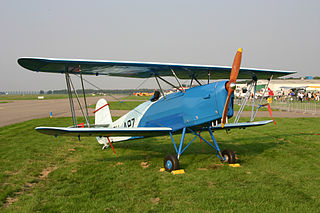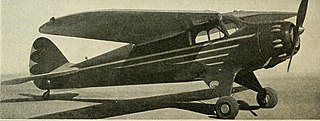Related Research Articles
The Comper Kite was a single-engined, two-seat touring monoplane built in the UK, derived from the contemporary Comper Streak racer. Only one was built.
The Pobjoy Pirate was a three-seat, high-wing monoplane designed to compete with the de Havilland Leopard Moth using a low power but light Pobjoy radial engine. Flight tests showed the Pirate to be uncompetitive and its development was rapidly abandoned.

The Pander P-1 and P-2 were close to-identical single engine Dutch sports aircraft with tandem seats and a parasol wing, first flying in 1929. Only two were built.
The Pander P-3 was a parasol wing, two seat, single engine sports aircraft designed in the Netherlands in the early 1930s. Only one was built.
The Pander Multipro was a two/three seat light monoplane aircraft with a high, braced wing, designed in the Netherlands in the early 1930s. Powered by a Pobjoy radial engine, three were built.

The Koolhoven F.K.47 was a 1930s one-off two seat biplane designed and built in the Netherlands for an individual customer as a sport and touring aircraft.
The Koolhoven F.K.44 was a two-seat, single engine sport monoplane designed and built in the Netherlands in the early 1930s. It was built to order, but only one was completed.

The Koolhoven F.K.45 was an aerobatic biplane built to the requirements of one pilot who flew it at airshows in the mid-1930s. Only one was built.

The Koolhoven F.K.54 was a Dutch single-engine, three-seat touring aircraft with a retractable undercarriage. It flew shortly before the start of World War II and its development was abandoned after its first flight as attention turned to military aircraft.
The NVI F.K.29 was a small Dutch biplane transport, carrying two passengers who boarded after the nose, with its single engine and fuselage, had been swung open. It was intended to link small local fields to main airports.

The NVI F.K.32 was a tandem two-seat biplane training aircraft designed and built in the Netherlands in the mid-1920s. It did not go into service.

The NVI F.K.34 was a three-seat reconnaissance floatplane built in the Netherlands in 1925 as a private venture in the hope of a Dutch Naval Aviation Service order; two accidents during testing meant that it did not go into production.

The NVI F.K.35 or Koolhoven F.K.35 was a two-seat fighter aircraft built in the Netherlands during 1926. It was completed and exhibited but, through a combination of ground accident and financial problems, never flown.

The Lambach HL.II was a single seat aerobatic biplane designed and built in the Netherlands to provide Dutch pilots in a local, annual competition with their own machine. It proved no match for contemporary Germany aircraft.
The NAVO RK-4/220 was a Dutch aircraft originally designed for unofficial crowd observation but which was completed as an airliner. Only one was built; it flew, but was never certified.
The Weymann W-1 was a French single seat biplane fighter aircraft, built during World War I. It had a most unusual layout, with an engine buried in the fuselage driving a pusher configuration propeller behind a cruciform tail. It was not successful and soon abandoned.

The Hanriot H.26 was a French single seat fighter aircraft prototype completed in 1923. Only one was built.
The Gribovsky G-25 was a Soviet tandem seat biplane basic trainer built in the late 1930s. It was hoped to minimize unit costs by using a modified automobile engine but the G-25 did not reach production.

The VIH Holland H.1 was a Dutch two seat, low-powered biplane. Only one was built.

The Swanson-Fahlin SF-1 was a high wing, two seat cabin aircraft with a small radial engine, designed in the United States and first flown in 1934. Only one was built.